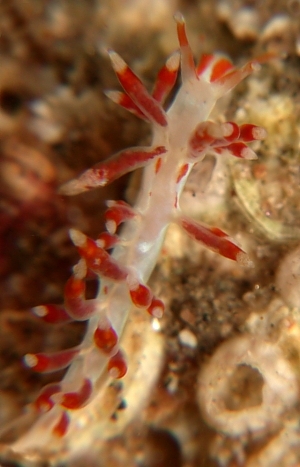
Eubranchus yolandae
Hermosillo & Valdes, 2007
Order: NUDIBRANCHIA
Suborder: AEOLIDINA
Family: Eubranchidae
DISTRIBUTION
Known only from Bahia de Banderas on the Pacific coast of Mexico.
PHOTO
Locality: Los Arcos, Bahía de Banderas, 52 feet, Jalisco, Mexico, tropical eastern Pacific, 26 May 2004, Rocky subtidal. Length: 7 mm. Photographer: Ali Hermosillo.
Animal translucent white with a dusting of opaque white along the sides. Through the dorsal body wall a zig-zag pattern of opaque whitish digestive gland ducts can be seen running to the ceratal rows. There are two thick red bands on the head running from the rhinophores to the anterior edge of the head and there are streaks of red on each side of the body between the ceratal clusters. Both the rhinophores and oral tentacles are translucent with a broad subapical band of red dusting. The ceratal wall is translucent clear except for a subapical band of red. The red digestive gland and the translucent white tip give the whole ceras a look of being red with a white tip.
The animal is quite elongate and the cerata are arranged in quite widely spaced rows down the body. The anus is situated dorsally about midway down the body. The largest animal found so far was 6 mm long alive
- Hermosillo A. & Valdés, A. 2007. Five new species of Aeolid nudibranchs (Mollusca, Opisthobranchia) from the Tropical Eastern Pacific. American Malacological Bulletin, 22: 119-137, 13 text figures, 1 color pl.
Rudman, W.B., 2007 (August 6) Eubranchus yolandae Hermosillo & Valdes, 2007. [In] Sea Slug Forum. Australian Museum, Sydney. Available from http://www.seaslugforum.net/find/eubryola
Related messages
Eubranchus yolandae from the tropical eastern Pacific
August 8, 2007
From: Ali Hermosillo
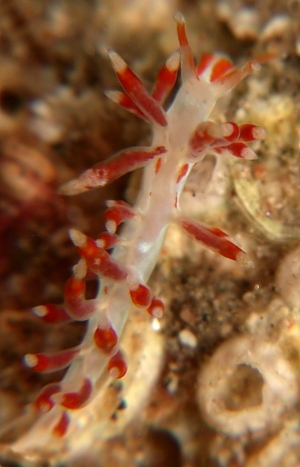
Dear Bill,
Last but not least, here is Eubranchus yolandae.
When Angel and I were working on this paper, the SEM had some problems and we could not get the image of the radula of this species, which we were almost sure was a Cuthona since it had all the external and reproductive characteristics of this genus.
What would be our surprise when the SEM finally came out and we saw the radula had a rachidian and laterals. For those of you who are not familiar with what that means here is a little explanation. The great majority of aeolids have a radula ribbon with only a central rachidian tooth, meaning one tooth per row. Very few genera (Flabellina and Eubranchus included) retain one small lateral on each side.
Locality: Los Arcos, Bahía de Banderas, 52 feet, Jalisco, Mexico, tropical eastern Pacific, 26 May 2004, Rocky subtidal. Length: 7 mm. Photographer: Ali Hermosillo.
Though small and hard to find, even at night, this species does not seem to be rare, you just have to find the eggs first.
Cheers!
Ali
gueri25@hotmail.com
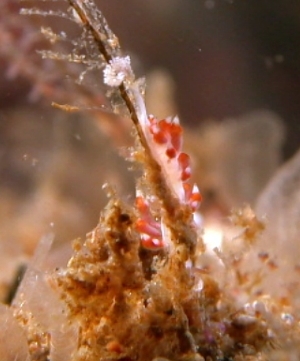
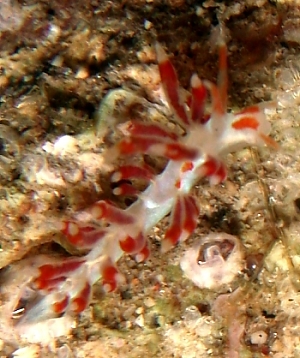
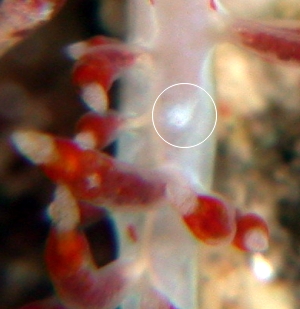
Dear Ali,
Thanks for the nice photos and background information on these species. This is another brightly coloured species.
I have a couple little points about your description. You describe the anal opening as acleioproctic, which is the usual position in Eubranchus, outside the ceratal clusters - above them in fact. From your photos I would think the anus is in the white patch I have ringed, rather than 'at the same level of the lower cerata' as described in your paper, which is a cleioproct position.
The second point is I think the pattern of "fine opaque yellow lines .. along the dorsum" which you describe, are the fine digestive gland ducts which run between the ceratal groups.
Best wishes,
Bill Rudman
